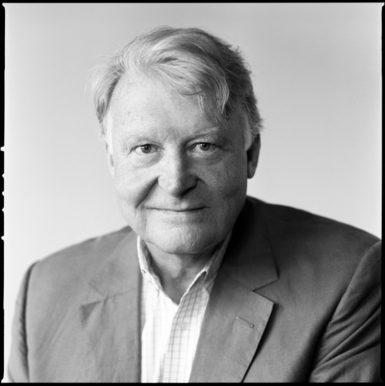[ad_1]

Phillips’s new home at 432 Park Avenue in New York.
Phillips auction house is gearing up for a big move. By the time the spring auctions roll around next May in New York, Phillips will be ensconced in its brand new global headquarters, at 432 Park Avenue. It’s just around the corner from its current building, but it will be a world of difference: starchitect-designed (Rafael Vinoly); 55,000 square feet; replete with an enormous, double-height, column-free space; and affords Phillips executives with fancy new office space. The top among those executives is, of course, its CEO Ed Dolman, who began working for the house in 2014, after 30 years at Christie’s and a brief stint working for the Qatar Museums Authority. ARTnews sat down to speak with Dolman this past May, just before the last round of New York evening sales, to talk about the move, the state of the art market, and more.
ARTnews: You have said that the art business has never been as exciting, even after saying at the Art Business Conference in April, “I don’t think the auction house business model is sustainable long term.” Given the issues we know of in the auction business, why is this an exciting time to be in it?
Ed Dolman: Because it’s just so much bigger—the whole business—than it used to be. Look at the Old Masters pictures market. It’s a very small, defined market, which hasn’t really grown. It’s probably the same size it’s been over the last 20 or 30 years. But the overall market has just boomed. It’s nothing like the business was in the 1990s. The postwar and contemporary art scene came out of a very small part of the businesses of Sotheby’s and Christie’s and now, just in terms of transactions, values, number of people, it’s completely transformed the whole business.
The challenge that everybody’s got in the market is keeping pace with that, staying relevant, making sure you’re positioned in the right way in front of the right people, and how you communicate with them. So auction houses are now dealing with many more clients than they used to and have much higher levels of value across much bigger geographical spreads. I mean, it’s Beijing, it’s Shanghai, it’s Hong Kong…
AN: What specifically is Phillips’s strategy in Asia and how would you differentiate that from what the other houses are doing?
ED: We’ve decided to focus clearly on international art. We were the first auction house to have 20th-century design: furniture, tables, etc. And we have what I think is exactly the right mix right now of KAWS, George Condo, Tsuguharu Foujita. This mix of Asian and international 20th-century works of art is exactly what the client base wants out there. They’re not as pigeon holed anymore; they see Chinese contemporary art as part of this bigger market place. And they’re interested in Warhol, Lichtenstein, etc. So, we’re going to continue to do that. I think Sotheby’s and Christie’s have always had these monolithic Asian contemporary art, and they’re beginning to mix a bit of international 20th century into it, but we started from that point and we’re going to continue to do that. We’re going to stay focused on what we do well: 20th-century design, prints, photographs, contemporary art.

Phillips CEO Ed Dolman.
BRIGITTE LACOMBE
AN: In the auction room, it’s becoming a situation, in a way, where the people are kind of the audience for the sale. They’re watching the spectacle but the bidding’s happening from very far away.
ED: Certainly for the main, high value sales. For some time now, most of the bidding is done remotely. And the people in the sales are the dealers and advisers who need to be seen to be part of the market. So they need to be there to be seen—but most buying at the high level is done as anonymously as possible.
AN: I wanted to talk a little bit about the day sales because Phillips is making big numbers there. Was that an unexpected result for you or was that a strategy?
ED: It was definitely part of a strategy. But I have to say it’s worked very well. We started at sort of $5 million. I suppose our broad-brush strategy, certainly something I wanted to do when I came here, was just to get Phillips into the conversation. The day sales, I think, have been almost the principal beneficiary of that because we’re now talking about so much more business than we were talking about before. So, it’s been very reassuring for me in particular to see how these day sales have grown. And, of course, from a business perspective, it’s quite a good revenue generator.
AN: Because it’s the $3 million to $5 million territory where they actually make money.
ED: As soon as you get to $50 million and $40 million…oh my god. If you do have a guarantee the revenues are pretty small, and if you don’t have a guarantee, the risks are huge. So, the day sale’s a very safe place to be in comparison. This exponential growth in our day sales has been fantastic for us.
AN: In the past, collectors used to buy and hold. When do you think was the last time an auction house specialist advised a client not to sell because they bought the work too recently and the price was too well known?
ED: Ten years ago. But what’s happening now is that the collectors have changed. They want to be there at the beginning when an artist emerges. If it’s not working for them, they’ll sell. Their own tastes will change but they’ll take a profit if there’s a profit. People bought Mark Bradford a few years ago for $600,000 can now get $4.5 million might sell and move on and use that money somewhere else. It doesn’t necessarily mean they don’t care about the art, they’re interested in that. But they want to be holding the right things and the right artists. And that does create much more churn in the market. So you get individual pictures coming up three or four times in the same number of years and no one blinks an eye.
The private museums that are going up. They’re buying iconic works and hanging on to them, but there’s also quite a bit of trading going on. People like François Pinault have never apologized for selling art. He wants to ride the wave of contemporary taste and he wants to be there in front of it.

Ed Dolman holds court at Phillips’s New York 20th-century art evening sale in 2017.
JOHN DOLAN
AN: Recently, you commented that third-party guarantees pre-arrange sales that lock the auction buyers in so they don’t have the flexibility to bid on the other lots.
ED: The market and the auction process is much less fluid. The position is locked more in advance than they had been before and we were beginning to see what I felt were some quite good pictures that were not guaranteed not selling because everybody was locked into deals and they weren’t able to walk away from that.
AN: So, is it not great to have that kind of inflexibility?
ED: I think what’s happened is that the market is much less boom-and-bust than it was. It’s been much more managed. The pricing is more stable, but the management of the market has led to slightly less vibrant activity in people’s tastes in the weeks or the days running up to the sales themselves. In the last few seasons, quite a few of the third-party guarantors have ended up buying. At the height of the market, when they were backing deals and not buying them, they’d get a nice fat check for doing that and then go and buy something else. Now, you see a lot of third party bids being locked in the day before a sale or even when the cookie has crumbled and everybody knows where they are, that’s what they want to do. But it does mean that the general feel of the sales is much less exciting than it used to be.
AN: What to you is the most significant part of your upcoming move to a new building?
ED: It’s a fabulous, big, high-ceiling, column-free space, which will allow us to really experiment and do some quite interesting things with the way we view things and the way we stage exhibitions, which is difficult in our present building because it’s on a number of floors and some of the ceiling heights are not high, etc. I’m hoping that it mimics the success that we had in with the sales room in London. It’s just stunning and it’s completely transformed our presence in the market.
[ad_2]
Source link

